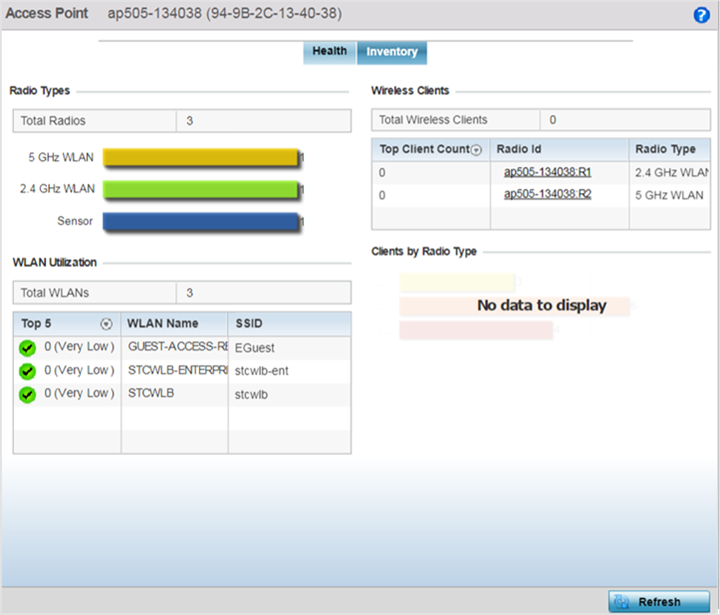Access Point Inventory
The Access Point Inventory tab displays granular data on devices managed by the selected access point. Information is displayed in easy to read tables and graphs.
To review the access point's inventory of connected devices:
- Go to .
- Select and expand an RF domain to expose its member controllers, service platforms or access points.
- Select an access point. The Health tab displays by default.
- Select the
Inventory tab.Access Point Dashboard - Inventory Tab

The information within the Inventory tab is partitioned into the following fields:
- The Radios
Type field displays the total number of radios
utilized by this access point. The graph lists the number of
radios in both the 2.4 GHz and 5 GHz radio bands. Refer to the
Total Radios column to review the number of
managed radios. Additionally, use the bar graphs to assess the
number WLANs utilized by
supported radio bands.
Periodically select Refresh (at the bottom of the screen) to update the radio information.
- The WLAN
Utilization table displays the top 5 WLANs
utilized by this access point in respect to client support.
The first table lists the total number of WLANs managed by
this system. The second table lists the top five (5) WLANs in
terms of the usage percentage along with their name and
network identifying SSID. The
utilization index measures how efficiently the RF medium is
utilized. It is defined as a percentage of the current
throughput relative to the maximum throughput possible. The quality is measured as:
- 0-20 – Very low utilization
- 20-40 – Low utilization
- 40-60 – Moderate utilization
- 60 and above – High utilization
Periodically select Refresh (at the bottom of the screen) to update WLAN utilization information.
- The Wireless Clients table displays information about the wireless clients managed by the selected access point. Information is presented in two (2) tables and a graph. The first table lists the total number of clients managed by the listed access point. The second lists the top five (5) radios in terms of the number of connected clients. The graph just below the table lists the number of clients by radio type.



